ENTS,
On Friday August 31, 2007, Carl Harting and I (Ed Frank) visited
the Holden Arboretum just east of Cleveland, Ohio. Mary Byrd
Davis
in her book "Old Growth in the East - a Survey"
suggests that there
is perhaps 40 acres of old-growth forest in the arboretum
property,
that had been selectively cut sometime in the past. The trip was
put together on a short notice given that Carl was working long
hours and in the middle of moving from one house to another.
Various website describe the arboretum: "The Holden
Arboretum, in
Kirtland, Ohio, USA, is one of the largest arboretums and
botanical
gardens in the United States, with over 3,500 acres (1,376 ha),
600
acres (243 ha) of which are devoted to collections and
gardens."
Of the 3,500 acres, nearly 3,000 acres are natural areas.
"Approximately
80 percent of Holden’s natural areas are woodland; 15 percent
are
meadows; and the remaining five percent are
wetlands, streams, river, ponds or lakes. Holden is blessed with
abundant natural resources that range from the unique land
itself
to the hundreds of native plant, animal and insect species that
live within these lands. For the past 75 years The Holden
Arboretum
has been acquiring land in order to protect these natural
resources. Unfortunately, today, it is not enough to just own
the
land to protect its natural biodiversity; active management is
needed." "Holden is home to two National Natural
History Landmarks,
accessed by guided hikes, and is Midwest representative for The
Center for Plant Conservation."
Given the short notice I wrote an email to a likely looking name
on
the staff list on their website http://www.holdenarb.org
and
received a reply from Dawn Gerlica, Field Botanist at the
arboretum. I explained that Carl and I were members of ENTS and
were interested in seeing and measuring old and big trees on the
arboretum property. I mentioned the Mary Byrd Davis reference and
provided a link to our tree measuring guidelines document.
Dawn explained that she had have set out permanent plots and
surveyed all of the natural areas. "I can easily show you
at least
two sites where there are general big trees - Bole Woods and
Corning Woods. Apparently Corning Woods is the area referred to
in
Mary Byrd Davis' book. My supervisor is the one who talked to
Ms.
Davis and led her around here. Unfortunately he is on vacation
on
Friday or her would offer to take you around. Little Mountain
has
some scattered ~300 year old white pines and and hemlocks and I
might be able to get you to see some of those, but it's nowhere
near the other areas. Many of the big trees that are my
favorites
are single trees scattered here or there and I can't get you to
all
of those right now. I'm not sure they'd all qualify anyway
because
although they are huge and old, they are often 'wolf trees' -
originally open grown and with several main stems instead of one
so
their height may be compromised." I told her big
"wolf" tree would
be excellent to see along with the other areas she suggested.
In a later email she noted, "The Holden Arboretum is 3500
acres of
land and less than 900 of that is the open grounds where normal
visitors can go without a guide - either in gardens or in
natural
areas. Most of our big trees are in closed natural areas -
places
that are inaccessible to visitors without a guide either because
the terrain or the community itself makes the journey more risky
for injury, or because the area is rare or fragile in some way
and
too many visitors can endanger that habitat. Some of our big
trees
are in public areas, but many are hidden away where no one is
supposed to get to them without a guide." She also provided
info
on where to find some trees in areas open to the general public.
We agreed the best use of our time would be to go with her to
areas
normally closed, and to try to get an overview of the
properties.
Carl and I arrived late Friday morning and ask for dawn at the
visitors center. In a few minutes she stopped down, we picked up
our gear and she took up to the office building. We two other
people who would also be accompanying us on the excursion -
Jennifer Hilmer, Land Steward in charge of invasive plant
control
http://www.holdenarb.org/Press%20room/interviews.htm
and Gary
Tabaj, a long time seasonal employee involved in the invasives
program. Dawn had printed out a large scale air photo for us
with
the various land classification information overlain on it prior
to
our arrival. Soon we all piled into an arboretum pick-up truck
and
headed off to look at trees. Apparently they had checked out the
ENTS website and Tree Measuring Guidelines - Jennifer told us
that
when she saw it her reaction was "Wow! these guys are
serious." The
arboretum does have tree documentation program, but it generally
deals with girths rather than tree heights. They even have a kit
for use in children's activities in which they use a tape and
clinometer to measure tree heights. (I would rather they used
the
stick method as it is overall better mechanically).
Dawn said that people are visiting the Arboretum all the time to
see
various collections, events, or flower displays, but that it was
rare that someone was coming the the arboretum to actually see
trees.
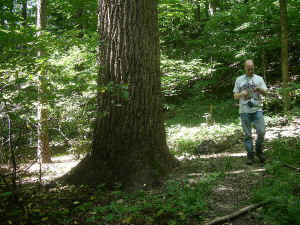 |
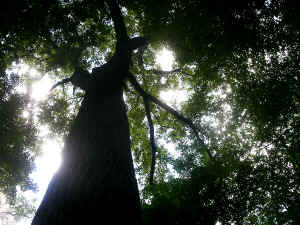
Black Walnut |
Our
first stop was an unscheduled one to measure a large Black
Walnut
tree. The tree had a girth of 11.2 feet, and a height of at
least 126.9 feet.
The height 1sn't very good. The canopy was very thick and we
could not
get a good top. I explained the basics of how we were doing the
measurements, the directional error, etc.
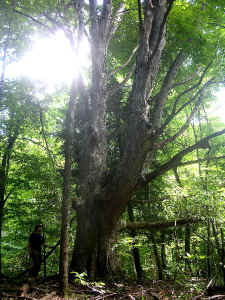 |
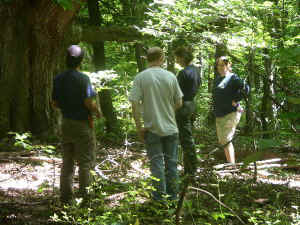
Large Red Oak wolf tree - Greg Trabaj, Carl
Harting, Jennifer Hilmer, and Dawn Gerlica |
Then onward
to look at an oak tree. We parked along the road and
headed off into the woods. This was a recently acquired property
along
the boundaries of the arboretum. The forest floor was was a
patchwork
of invasive plants and barren ground under the canopy. Present
included
multiflora roses, garlic mustard, Japanese barberry, even and
holly
among others. The litter was gone on much of the area. it looked
as if
the area had been washed by a recent flood, but more likely it
represented an earthworm invasion front. The idea ws spoken
aloud by
Gary Tabaj, but was what Carl and I were thinking after reading
many
posts, and seeing presentations by Lee Frelich. We hiked back
into the
woods and up along a small drainage to a magnificent old
wolf-tree of a
red oak. It was gnarled, with a thick trunk, and low thick
branches,
definitely it had grown along a field boundary before the field
around
it had grown into the younger forest around us. We tried but
could not
get a good shot of the top from anywhere, but resigned ourselves
to
shooting up from underneath to get a feel for the height of the
tree.
This wasn't a very impressive showing of our tree measuring
capabilities, but given the short time available, we could not
hunt for
long at a single tree looking for a workable shot of the top
before we
had to move onto a new location. On the way out Carl and I
paused
briefly to look a a big cucumber tree alongside the trail. It
was
easily over 110 feet tall. Back at the truck Gary was listening
to me
and Carl explain about the cucumber tree in stereo. We were
outside and
I was telling him it was a big tree and that the tallest in PA
was a
131 foot high specimen at McConnell's Mill, while Carl was
simultaneously
telling Dawn and Jennifer the same thing in virtually the same
words.
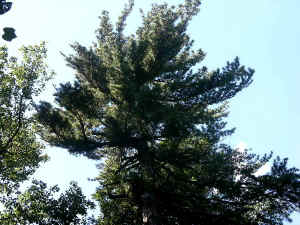
Large Pine with a bent top in Little
Mountain Area |
The next
area we were headed to was Little Mountain which Dawn
said had some scattered ~300 year old white pines and and
hemlocks. This was a resort spot in the late 1800's to early
1900's for the rich and famous, including a few
presidents. At the
Little Mountain Resort. Most buildings are all still there, the
paths are
still there, but it is no longer open. Found along the trails
are plaques
noting locations of a former church, and of activities that once
took place
there. We followed a horse trail to look for some large white
pines and
hemlocks. Several white pines and hemlocks were measured but
none
were exceptionally tall or large. They were nice trees anyway.

Beech with "carvings" and a large
sugar maple to the right in Corning Woods Area |
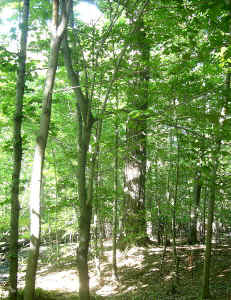 |
The final goal for the day was Corning Woods. Dawn wrote in an
earlier
email, "Corning Woods is a closed natural area only because
there is no
parking near it and no trail that will get you there from any of
our
other property. I can show you that and the trails there that
the
neighbors have built on our property. It's easy walking, but you
have
to park on the side of the road and I think we can get you a
pass to put
in your window so no one will bother you." We drove along
the outskirts
of the arboretum and looked at some f the development
encroaching on the
area. Occasional glimpses of Lake Erie could be seen off in the
distance to te north. There is a slow but steady rise from lake
level
to the level here at Kirkland gaining perhaps 1,400 feet in
seven or
eight miles.
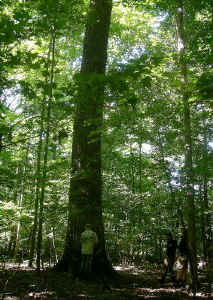 |
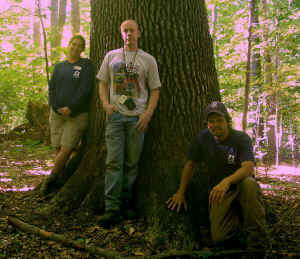
Large Oak in Corning Woods, Dawn Gerlica, Carl
Harting, and Greg Tabaj |
Corning Woods was completely different in character. The woods
were not
overrun by invasives but had a natural character. Immediately
off the
road were big oak trees - chestnut oaks, red oaks, and white
oaks. The
area also had large beech trees. Overall I would characterize
the area
as dominated by oaks and beech. Other species present included
American
Elm, Sassafras, Black Gum, Sugar Maple all large in size.
Several other
species were represented by smaller specimens. It is a beautiful
patch
of old growth forest consisting of 5 to 10 acres of large trees.
There
is much more to measure and document in this small patch of
woods.
From here we returned to our vehicle, and prepared to head home.
I gave
out a couple printouts of our Tree measuring guidelines and
thanked them
for their hospitality, and promised we would be back. Carl and I
wondered about the parking area and nearby grounds. Carl was not
very
good at identifying various Chinese Oaks, but otherwise did a
fine job
of identifying the trees planted around the lot.
Carl and many of the others are better measurers than I am. I am
not
saying that my measurements are bad. My figures are right on the
money,
but my notes are always a mess. I find myself when out in the
woods
thinking about taking photographs. I am exploring the woods and
enjoying the moment. I am hugging a a big sassafras to see how
big it
is. I am stopping to look at a toadstool. I am afraid I lack the
focus
others seem to have to concentrate on measuring trees when I am
out
walking about. When I do measure, the measurements are fine, but
sometimes, I forget to measure.
I will post the measurements for the trees when Carl and I get a
chance
to consolidate measurement information (Basically that means I
will copy
Carl's information to augment my pitiful few measurements).
Ed Frank
|